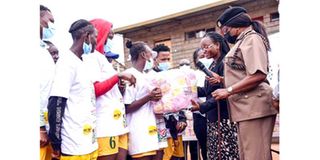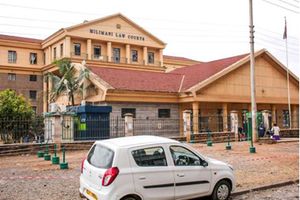Drive to tackle pregnancy, SGBV, HIV threats to teens

Health Principal Secretary Susan Mochache (second right) and Nairobi County Commissioner Flora Mworoa distribute sanitary pads in Mathare Youth Sports Association Grounds, Nairobi, on July 5, 2022. They sensitised community and opinion leaders to Triple Threat (teenage pregnancies, sexual and gender-based violence and New HIV Infection) among adolescents.
What you need to know:
- Globally, about 15 per cent of young women give birth before age 18, according to the World Health Organisation.
- Kenya, as per WHO data, has a birth rate of 96 per 1,000 among the 15-19 teenagers.
The Ministry of Health has launched community sensitisation drives to tackle the triple threat of teenage pregnancy, risk to HIV infection and sexual and gender-based violence (SGBV).
On Tuesday, during the roll-out of the first drive in Mathare, Nairobi County, Health Principal Secretary Susan Mochache said cases of SGBV among those aged 10–19 have in the past five months declined by seven per cent compared to the same period in 2021.
She said the triple threat undermines the health, education, and economic empowerment of adolescents. “Our legal frameworks and policies are designed to protect the rights of all citizens, including women and girls, against all forms of violence. But these laws can only protect their rights if they are always fulfilled or supported by society and its leaders.”
Career and educational prospects ruined
Globally, about 15 per cent of young women give birth before age 18, according to the World Health Organisation (WHO), which notes: “Many pregnant girls are pressured or forced to drop out of school, which can impact their educational and employment prospects and opportunities.”
Further, it says early pregnancy and childbearing lead to the girls’ reduced status in the home and community, stigmatisation, rejection and violence by family members, peers and partners.
Kenya, as per WHO data, has a birth rate of 96 per 1,000 among the 15-19 teenagers. Further, 26 per cent of its women aged 20–24 gave birth before age 18, according to the United Nations Population Fund, making it one of the 40 countries with the highest rates of teenage pregnancies.
In 15 countries, there are more than 30 per cent,14 of which are in sub-Saharan Africa.
PS Mochache said that in 2021, about 21 per cent of the total 317,644 pregnancies recorded were among the 10-19 year-olds. And nine counties, namely Nairobi, Kajiado, Homa Bay, Meru, Kericho, Narok, Kisii, Mandera, and Bomet, contributed 56 per cent of pregnancies among the 10-14 years-olds.
Notably, data from the Health ministry shows that one in three adolescent girls have experienced some form of violence, including SGBV, which increases their risk of HIV infection.
“We must acknowledge that every teenage pregnancy is clear evidence of unprotected sex that carries with it other risks beyond pregnancies,” she said.
In 2021, at least 98 new HIV cases occurred every week among adolescents aged 10-19, she said.





